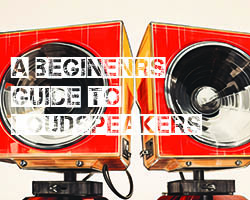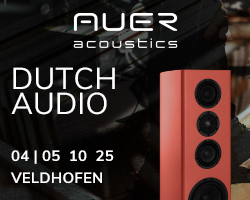JANINE GETS TO GRIPS WITH CHASING THE DRAGON’S DIRECT TO DISC RECORDING OF VIVALDI IN LONDON
Janine Elliot takes a listen to Vivaldi in London from Chasing the Dragon and discusses the direct to disc recording of this ambitious project.
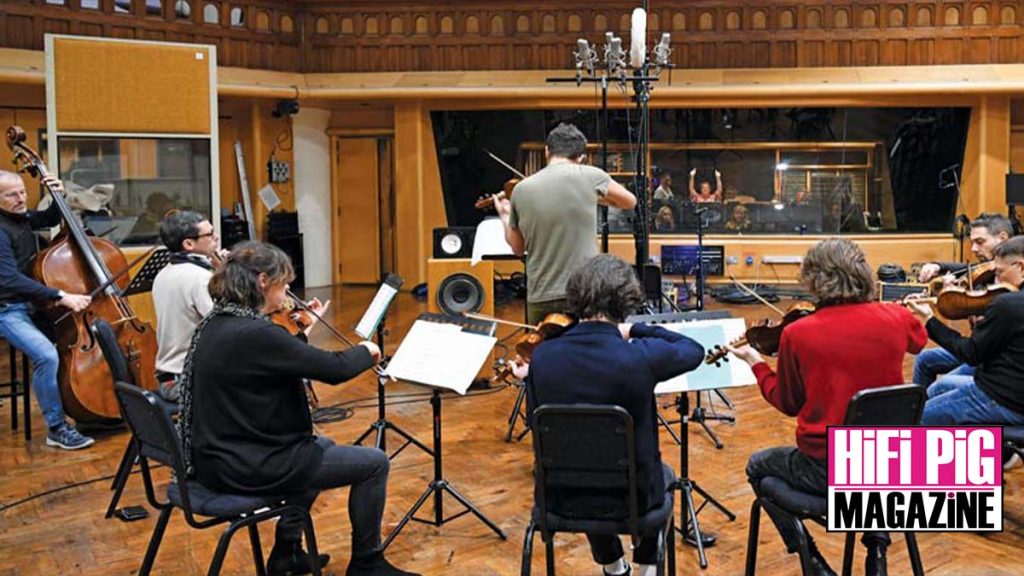
Chasing the Dragon has been releasing Direct Cut discs, HD downloads, CDs, and Reel to Reel reels for nearly 10 years. They are a small company run by husband-and-wife team Mike and Françoise Valentine. It started with the original “Chasing the Dragon” compilation CD including a cello solo in a field and a piano solo in a hall followed by one in a studio with no less than 6 microphones, plus musical tracks showing how things can sound in different conditions and with different microphones. I love this album. In the sequel to this album he even recorded the sound of a London underground train! I have also personally been present at a number of Chasing the Dragon recording sessions over the years and have always been impressed with the recording and performance quality, having for many years worked at the BBC as a sound engineer, just as is Mike’s own background (including setting up Live Aid stage microphones). Not content with audio he now works with photography, regularly filming deep in the ocean for major films such as the last 5 James Bond movies, Star Wars Episode 1, Trainspotting, and Bourne Supremacy, to name but a few. The flamboyant Mike can always be seen at HiFi shows wearing clothes as bright as his personality and humour. At the Whittlebury Hifi Audio Show Deluxe visitors were able to hear about the latest recording, ‘Vivaldi in London’, a sequel to the highly enjoyable ‘Vivaldi in Venice’, which I regularly use as my “go-to” LP for equipment reviews. That album, featuring the Interpreti Veneziani 9-piece string and harpsichord nonet, is my favourite Baroque album. So, could another album from the same musicians impress me even further?
CHASING THE DRAGON vs COLDPLAY
Whereas the original album was a live recording made in Venice in front of an audience, this album was recorded at the Air Studios in London. It might not have been “live”, but since this performance was being recorded onto direct-cut-discs, this needed to be done ‘as live’. More on all that later. For this review of the double album I was kindly sent two reel-to-reel tapes of the recording, available at £700 for both.
Between 11th and 12th December 2023, the recording session took place. The album was to be recorded in the Studio 1, but because the session was booked in the middle of a larger booking by no less than Coldplay, the pop band didn’t want to have to de-rig in the middle of their 2-week recording session, so offered Chasing the Dragon the option of moving to the much larger “Hall” and them paying the “difference” in the fee, which amounted to £6000! Be warned all you budding record producers, booking recording studios and musicians is a very costly experiment, even before you get to producing the LPs, CDs or reel-to-reels! Moving into the Hall was a great move as it meant natural, rather than digital reverb could be deployed to make the recording sound real, though a number of screens needed to be deployed around the musicians to “control” the amount of refection.
Having informed Interpreti Veneziani that Chasing the Dragon wanted to record them again gave the ensemble the added responsibility to choose 8 pieces of music for the double album. In the end they chose 5 new pieces, but resorted to include Vivaldi’s Concerto for violin, strings and harpsichord RV386, the Violin, Cello, strings and harpsichord concerto RV546, and the RV419 Cello, strings and harpsichord Concerto that had already appeared in the ‘Vivaldi in Venice’ album. I was so glad to see these appearing again as they were my favourites from the Venice album (particularly RV419), and the ensemble had asked Mike if he minded if they include them again for their “own use”.
The performances were brilliant in Venice, so could they be bettered in the new album?
Having performed these and other concertos by Vivaldi, Tartini, and Corelli in the live performance at the San Vidal Church would have been very nerve-wracking for any musician however professional, but recording in a studio ‘direct to disc’ seemed to make them even more nervous! On a direct-cut-disc there is no room for errors as you can’t simply stop when you make a mistake and retake the section! The 20 minutes of the disc needs to be done in a complete single take without mistakes! Consequently, the ensemble rehearsed for three months every afternoon to make sure their playing was as musical and perfect as possible. For the recording session there were to be 8 master laquer discs, so that there was a total of two of each side of the double album to choose from. Interestingly, in the listening session later all ears preferred the second “take” of each side/performance, and these were therefore chosen for the final product. Digital FLAC/DSD recordings were also made at the recording session for the digital versions of the product (downloads and CD). For the reel-to-reel version of the double album this was made on an 8-track Studer A80. The 6 microphones were recorded individually onto 6 channels of the machine and a mix-down on a Neve Summing mixer was later recorded onto a ½ inch 2-track Studer A820 reel-to-reel. Like the Neve desks at Air Studios, the Summing mixer electronics had been reconditioned and with new output transformers, to give them a superlative and audiophile sound. The desk just has level and panning control, so the resultant sound is as pure as possible, no horrible EQ electronics in sight.
THE PLAYERS
Interpreti Veneziani is made up of 9 musicians. There are no less than 5 violins, just one viola and a cello and double bass, plus the continuo harpsichord. There is no lead violinist as such, with all musicians playing with equal responsibility and professionalism. Violinists are Giovanni Agazzi, Guiliano Fontanella, Nicola Granillo, Luca Ranzato and Francesco Zanchetta; viola player is Sonia Amadio; cellist is Davide Amadio; double bass is Angelo Liziero, and the excellent harpsichordist is Alberto Maron. Violin and cello soloists for the concertos are selected from the ensemble.
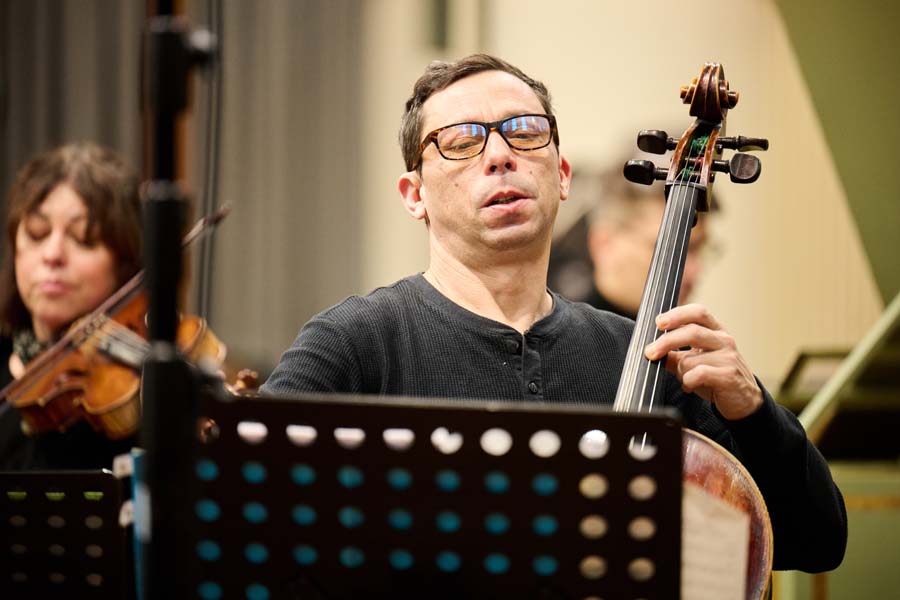
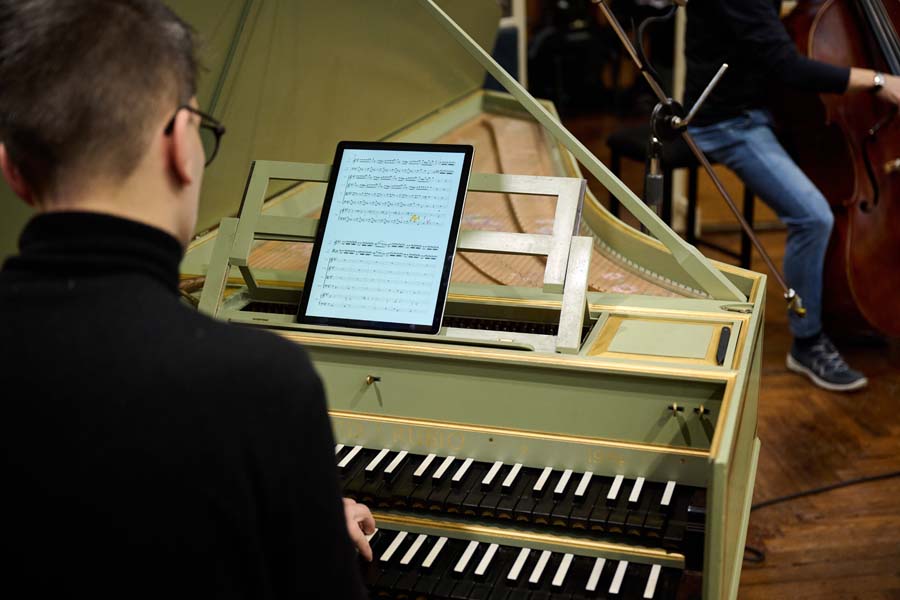
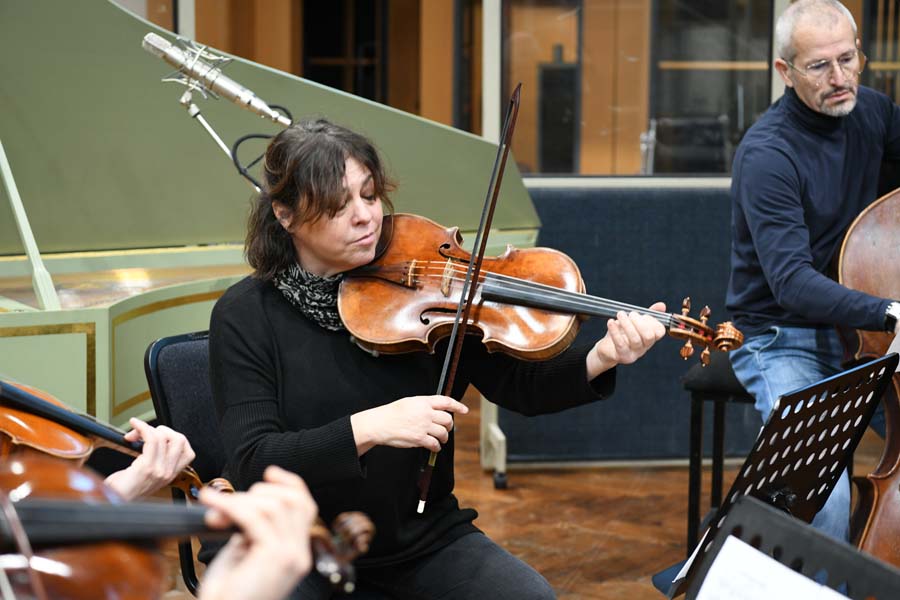
MICROPHONES AND CABLES
Whilst many recording engineers and producers would be happy to produce an album quickly and as cheaply as possible, Mike is no ordinary professional. As an audiophile, sound quality is of vital importance to him, and if that means producing on Direct Cut Disc and tape then that also means that as well as the best electronics the microphones and cables also need to be the very best you could use. The main microphone cables are 9-metre Nordost Odin-2’s which come in at £80,000, probably a lot more expensive than all the cables put together at Air Studios! Similarly, the microphones needed to be good, and only the very best were used, namely; ELAM 251’s as the main pair positioned to the left and right of the “stage” known as “out-riggers” (these are basically AKG C12’s made for Telefunken), Neumann U67’s as a pair positioned closer at the centre with a 14” sheepskin-covered Jeckin Disc between them to create an acoustic barrier between the two microphones set in omni-mode, creating a better stereo image. On the double bass and above the harpsichord are placed AKG C12’s set in cardioid pattern, meaning they only pick up what is directly in front of them. All microphones were valve, and produced a detailed but highly musical recording of the music. As mentioned earlier, Mike has often done tests between different microphones to see which is best suited. In his album ‘Mendelssohn Octet op20’ he uses different microphone setups for the “Gypsy Folk Song”, all set up for the same performance and giving the listener the chance to evaluate which microphones sound the best. Brilliant idea.
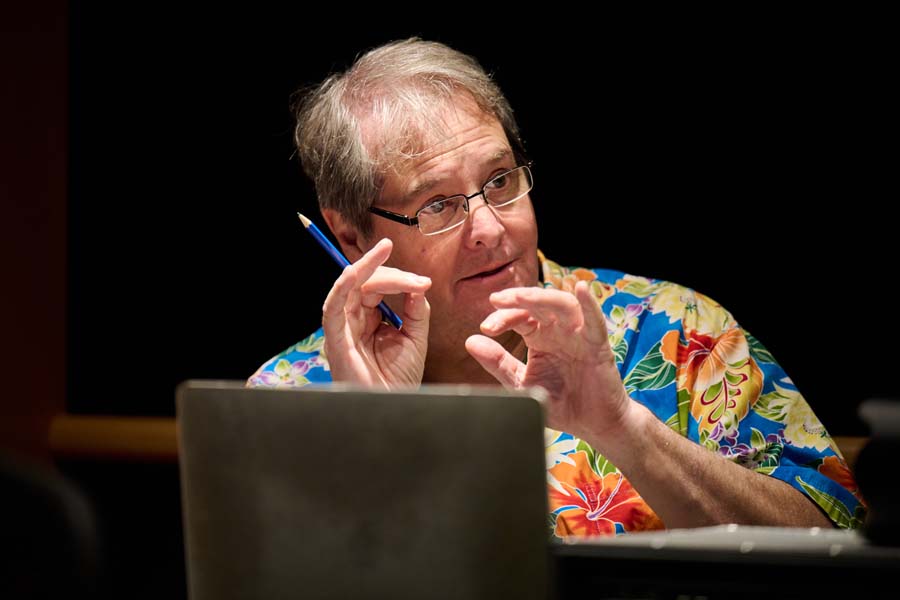
RECORDING PROCESS
Sound engineering the recording in the Hall was excellently operated by Jake Jackson, with the mastering engineer upstairs creating the direct cut discs on a Neumann VMS80 lathe being John Webber. In charge of the 8-track reel-to-reel recording was Petronel Butuc, renowned for his skills in rebuilding of professional reel to reel and cassette machines. Indeed, he had just serviced Mike’s aged 8-track Studer A80 reel-to reel, including bearings, electronics and tape heads.

THE RECORDING
Having recorded on the 8-track Studer in the Air Studios Hall, the mix-down to ½ track ½” master tape was done on a Studer A820, on 12” spools at 30ips, no less, at Mike’s own facilities. Copies were then put on two Recording the Masters SM900 tapes using a ¼ inch Studer A820 for purchase. I have to admit I was very impressed by the sound quality from the recordings made at 250nWb/m, however, I was surprised it wasn’t at 320nWb/m, as some of Chasing the Dragon reels are. Mike had considered that but felt the best sound would be made at 250nWb/m. In practice it actually meant it played better on my Sony TC766-2, as that machine is set up for this. The higher the number can mean some machines cannot play albums successfully at high recording levels. RTM SM900 tape can go as high as +9dB without too much distortion, though probably not good to try out on machines! The tapes are excellently packaged in the professional-looking RTM plastic case with a well-designed sticker on the front showing what’s being performed and photos. I just wished there was a little booklet inside to give details and photos of how it was recorded, and pictures of the musicians as can be seen when you open up the centre of the double-LP cover. However, the plastic container that the tape comes in doesn’t really give much space for any internal documentation. It is worth adding that many of CtD albums are available on ½ inch tape and also recorded ¼ track as well as at 7½ ips, and Mike is keen that purchasers have the most appropriate recording type for their machine. Buying a ½ track recording for a ¼ track machine, for example, will end up with one channel louder than the other!
THE MUSIC
I thoroughly enjoyed the music. It was great to hear some of my favourites from the ‘Vivaldi in Venice’ album, though 3 out of 8 works is a high number of ‘repeats’. The performances of those three works were just as enlightening as in the original album, though not exactly the same. Where the quality on my double-LP version of the former album was really great, the sound quality from this reel-to-reel tape just made me enjoy the music even further. Antonio Lucio Vivaldi (1678-1741) was an Italian composer born in Venice who wrote over 500 concertos and sacred choral works in his lifetime. He spent most of his professional life at the Ospedale della Pieta, a home for illegitimate children of Venetian noblemen and courtiers, starting off as a teacher in 1703. Part of his job was to compose music for the church, and later given the position of ‘Maestro di Concerti’. He moved to Vienna in order to gain a position at an Austrian court, having been in contact with Emperor Charles VI, but that sadly was not to happen as the emperor was soon to die after he arrived there and Vivaldi sadly died a pauper in 1741. He might have died in sad circumstances, but his music lives on and is some of the very best written. The key relationships in phrases are so cleverly used and in this album the performance from the musicians makes it so easy to get ‘involved’ in the music. As well as two microphones either side of the stage, the two Neumann U67s just in front of the musicians not only helps to give a very intimate performance but as the musicians move about on their chairs getting engrossed with the music you can even hear the sound moving about in the soundstage in places. This didn’t put me off at all, rather it made me listen more intently as it involved me more in the performance.
Each of the two reels or LPs have four works. The performance begins with the Violin Concerto in B minor, RV386 (‘RV’ stands for Ryom Verzeichnis, the catalogue of music set up by Danish musicologist Peter Ryom), as featured at the start of the Venice album and which also has Giovanni Agazzi as the soloist. This has excellent playing by the musicians, and the positioning of the instruments, particularly the harpsichord, was spot on. There is great detail from the musicians in the recording, with the lead violin scale runs being of great detail and beautifully performed. Where the Ferrograph Logic 7 gives a very musical “valve-like” performance, playing this same work on my Sony TC766-2 was much tighter and detailed with a louder harpsichord, but not so musical as on the Logic 7, which is closer to the original sound. With CCIR recording at 250nW/m the playback regularly hit +3dB on the meters, but there was no distortion. The high notes from the violin are very clear and biting; more so on the Sony TC766-2. Listening to the pieces on the Sony one feels part of the ensemble, sitting just a few feet away, closer than I was on the more professional Logic 7. Most of my listening was therefore done on the rebuilt Ferrograph. This is an epic recording. Between movements you can hear turning of pages by the musicians and this helps maintain the life-like recording and helps the listener feel part of the performance. I just wished at that the very end of the two reels we heard the musicians making a few comments or noises, like those that appear on some other Chasing the Dragon recordings, celebrating the fact that they had finished! I did feel that a few of the works began performing too quickly after the previous one; for example, after the A major RV546 the work goes straight into the RV547 which is a semitone higher in B flat, and just a little too quick for my musical brain to cope with! That said, what a lovely work to end the whole studio concert with.
The second work in the first reel to reel (side 1 LP) is the D minor RV242. This was just as exciting as the RV386, and is another concerto for violin, strings and harpsichord, also with Giovanni Agazzi on solo violin. The slow movement particularly allowed me to drift into a musical heaven; the performance was great and the sound just filled my room beautifully. I just wish this movement could have been a little longer. The final third movement has some beautiful running scales in thirds between the two top violins. The third work (which would now be side 2 of the first LP) is the RV383 concerto for violin, strings and harpsichord in B flat with Nicola Granillo playing the solo. Again, the slow movement was Vivaldi at his very best, and the performance could not be questioned as was the engineering. Finally, RV180 in C major has a very interesting first movement with solo violin chirping very high, like a bird singing in the countryside. Like the other works, this concerto was played with enthusiasm and panache.
The second reel-to-reel starts with my favourite RV419, due to its very exciting third music. This performance is excellent, though I preferred the one on the Venice album, which ends a bit more excitedly. But, as this was a “one take” recording, sometimes a few sections of a piece might not be quite as good as on another take but everything else on that performance is better. That’s life, and it certainly didn’t affect my affection for this great double-album. This concerto with cello solo is played by Davide Armadio, frantically bowing with amazing ease but sounding with great power. During my first listening to this I had swapped over my cables to Tellurium Q Ultra Silver ii that I was reviewing at the time, and this gave particularly good timing from the instruments. The last movement has really fast cello playing which was very clear and tuneful. The harpsichord bass notes were exceptionally clear and detailed, showing off this excellent reproduction keyboard. This harpsichord is not the one used in Venice, rather it is the same keyboard that was used on the Chasing the Dragon ‘Vivaldi Four Seasons’ album recorded at Air Studios, so Mike knew its acoustic qualities well. The performance was excellent, particularly at the end of the first movement. Interestingly the original harpsichordist of the Venice album wasn’t available for this recording so the ‘stand by’ harpsichordist was deployed, and an excellent job he does. The double-bass was perfectly positioned in the balance, helping me to fully appreciate the key modulations that make Vivaldi so special. Whilst Davide was positioned perfectly for the sound recording of this concerto, he also stayed sat in place for the concerto for cello, strings and harpsichord RV421 which followed, also in A minor. Another excellent recording and performance. For the last two concertos for violin, cello, strings and harpsichord, Davide was joined by Giovanni for RV546 and Nicola for the RV547 that finish off this two LP and two-reel concert. The first is in A major and quickly followed by the B flat RV547. What a fantastic work and performance to finish this epic 8-work rendition. The brilliant end to the slow middle movement from the harpsichord sounded superb in my listening room. Similarly, the last movement was cleanly and excitedly performed, completing the 32-minute second reel beautifully.
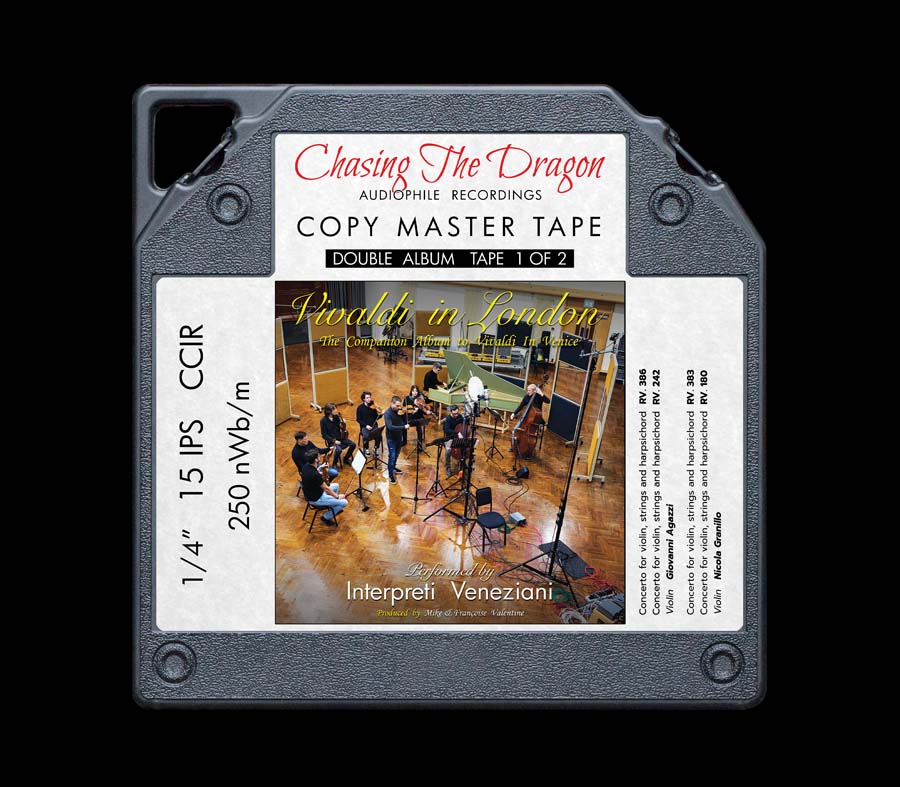
CONCLUSION
What an excellent double album! If you want technical perfection then this album is the better album from Interpreti Veneziani. Even the performance of the three works that also appear on the ‘Vivaldi in Venice’ album are quite different, making it an ideal second album to have if you already have the earlier one. For reel-to-reel lovers this is a brilliant double album, showing just how much better tape is to any other format. The performance is startlingly good for a “one take” affair. I couldn’t question the playing; tuning was excellent and there were no ‘bum’ notes. Only in one place did I not like the violin vibrato. All musicians were so focused on each other that you could imagine they are all connected by the same umbilical cord. The acoustics are perfect (less reverb than the Venice album, since that was in a great big church), and the sound engineering and mastering is nothing less than I would expect from Chasing the Dragon. Well done Mike and the team.
Price: £700 for two reels 250nWb/m 15ips CCIR
Tape 1
- Concerto for violin, strings and harpsichord RV.386
- Concerto for violin, strings and harpsichord RV.242
- Concerto for violin, strings and harpsichord RV.383
- Concerto for violin, strings and harpsichord RV.180
Tape 2
- Concerto for cello, strings and harpsichord RV.419
- Concerto for cello, strings and harpsichord RV.421
- Concerto for violin, cello, strings and harpsichord RV.546
- Concerto for violin, cello, strings and harpsichord RV.547
Test equipment
Ferrograph Logic7 and Sony TC766-2 (reel to reel); Music First Audio Baby Reference pre-amp, Synthesis Roma 98DC (amplification); Graham Audio LS5/9 (speakers); Esprit, Tellurium Q and Townshend cables, Coppice Audio stand and Townshend rack.

JANINE ELLIOT





















































